Post under construction.
The Porto Museum Silver and Silver Gilt Filigree and Blue Enamel Casket.
Museu Nacional Soares dos Reis. Porto, Portugal.
The photographs taken by the author October 2024.
No size available at present - I will attempt to contact the Museum.
see my previous post -
https://antiqueeuropeanfiligree.blogspot.com/search?q=enamel
17th/ 18th Century Silver Filigree and Enamel Casket.
The Veritas Auction Silver Gilt, Silver Filigree and Enamel
Casket
9 x 17 x 10.5 cms.
This is probably one of the two most overtly Chinese influenced
casket that I have discovered.
Silver Filigree and Enamel Casket Sold by Bonham's.
17th/early 18th Century - probably Batavia.
Related to the previously illustrated casket.
14.6 x 9.1 x 8.9 cm.
Sold Bonham's London, Lot 186. 11 June 2020.
Another casket with detail of the decoration showing distinct Chinese influence - Batavia was known for enamel work - so again tentatively - made by Chinese craftsman under European instruction.
14.6 x 9.1 x 8.9 cm.
............................
Christie's Amsterdam.
17th / 18th Century Silver Filigree and Enamel Casket.
This casket has two unusual features of this group, firstly
the blue enamel and secondly the engaged columns on the corners.
................................
17th/18th Century Silver Filigree Mounted Nautilus Shell with Enamelled Flower Decoration.
Previously in a Dutch Collection.
Silver, Lapis Lazuli Blue Enamel, Turbo Mamoratus
stand 32cm., 11 ¾ in. diameter
the polished Turbo Marmoratus shell with a silver-gilt frog
at the rim, filigree sleeve and screw-on detachable foot, applied with
cloisonné foliate reserves of blue
pigment, repeated at the stand on fixed foot with lotus flowers, leaves and
Ruyi border, stand with a later Dutch control mark1
https://www.sothebys.com/en/auctions/ecatalogue/2018/treasures-l18303/lot.11.html
Sotheby's Catalogue it as China or Sumatra.
...........................
The Berkeley Castle Filigree Mounted Nautilus Shell with enamelled flower Decoration.
suspect South German Augsburg or Nuremberg, but I still haven't got a real handle on 18th century filigree production in South East Asia.
Some researchers believe that these objects were made in Batavia, modern day Jakarta, Indonesia but until objects with an early provenance appear the verdict remains open.
The filigree flowers are decorated with blue enamelled details.
The enamelling is quite unusual and appears on very few pieces of filigree.
The photographs recently very kindly provided by Joshua Nash at Berkeley Castle.
.......................................
The Zebregs Roell Round Silver Filigree and Enamel Casket.
Their catalogue entry -
West Sumatra/Padang or Batavia, circa 1700, apparently unmarked
With soldered floral motifs filled with blue and green enamel.
H. 22 x Diam. 18 cms.
...................
The Zebregs Roell Catalogue entry states -
.
In Een bijzondere doos van zilver-filigrain (Aziatische Kunst, 32ste jaargang, Nr. 4, December 2002) Jan van Campen attributes the basket to Indian and Chinese artisans working in Batavia.
Jan Veenendaal (Asian Art and the Dutch Taste, Waanders Uitgevers and Gemeentemuseum Den Haag, 2014) on the other hand argues that this kind of silver filigree work is more likely to have been the work of Chinese and Malay silversmiths working in West Sumatra, Padang. However, the enamelling may have been done in Batavia.
The present basket certainly is very similar to a filigree box with green enamelling, modelled on a Chinese example, possibly from West Sumatra illustrated in Jan Veenendaal’s book (ill. 195 and 196) (see image below).
https://www.zebregsroell.com/indonesian-silver-filigree-basket
.......................................
And another Filigree and Enamel Piece Illustrated in the Sotheby's Catalogue.
from the collection of Jan Veenendaal.
...........................
"This filigree box was probably modelled on a Chinese example and was probably made in Padang, West Sumatra and was probably enamelled in Batavia and was probably used as a betel nut container".
17th Century Silver Filigree and Enamel Dish.
with engraved inscription dated 1686.
With dealers ALJ Antiques of Kensington Church Street, London
I am very grateful to Duraid al Jashamie of ALJ Antiques for allowing me to use his photographs and information.
https://www.aljantiques.com/antiques-category/inventory/available-stock/
Dangerous to make generalisations but the looseness of the design perhaps suggests less sophisticated South East Asian manufacture, perhaps under the direction of a Dutch craftsman or a loose copy of a dish taken from Holland to Indonesia.
The engraving reads "Ter ge-daghtenis van johanna see-(ve?)ter Obit den 23 juni 1682".
Duraid Jashami makes the case for the inscription translating as
In Remembrance of Johanna Van Seventer ‘Obit 23 June 1682.
............................................
I suspect it is missing the feet.
The catch appears to lack the sophistication of the rest of the work suggesting that it was perhaps added later.
https://collectie.wereldculturen.nl/#/query/4048910b-f7b4-4641-849b-1768d2bb7276
From the (very annoying) Dutch Museums website.
This form of casket with the domed lid is unusual but appears on several other caskets.
I am still unclear as to the origin of these caskets.
Here is a link to my blog post on the subject of the lateral domed caskets.
https://antiqueeuropeanfiligree.blogspot.com/2023/04/some-photographs-of-domed-silver.html








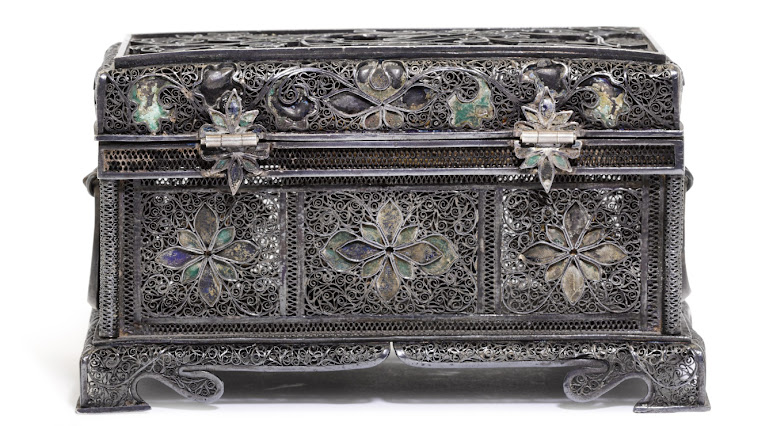
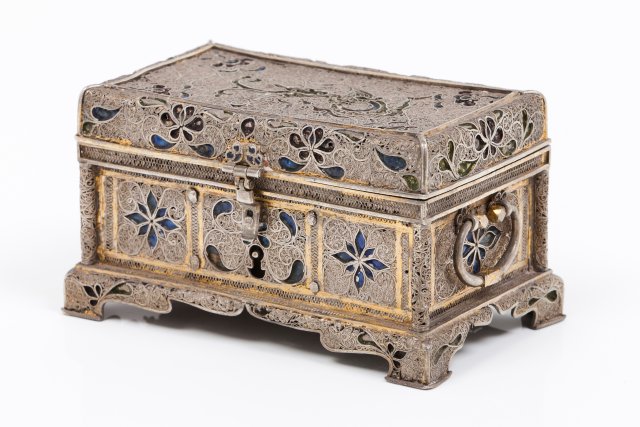

.jpg)

%20adj.jpg)


















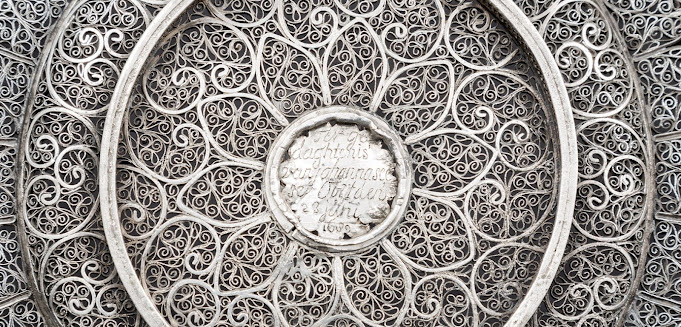
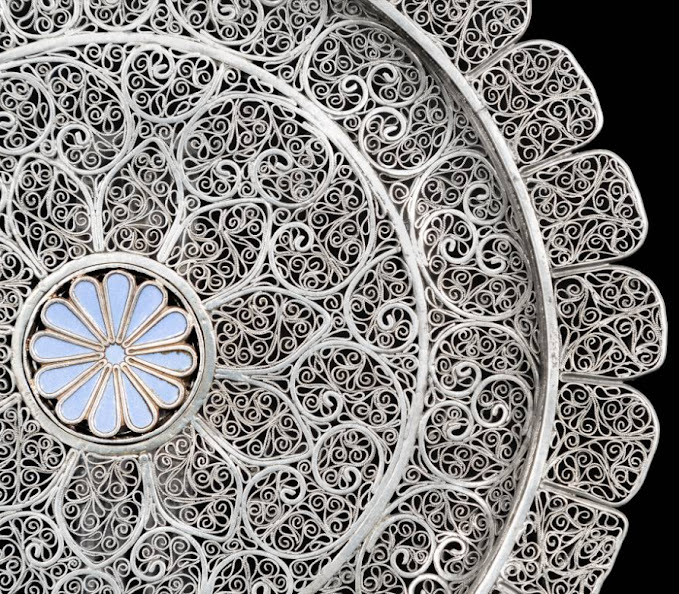



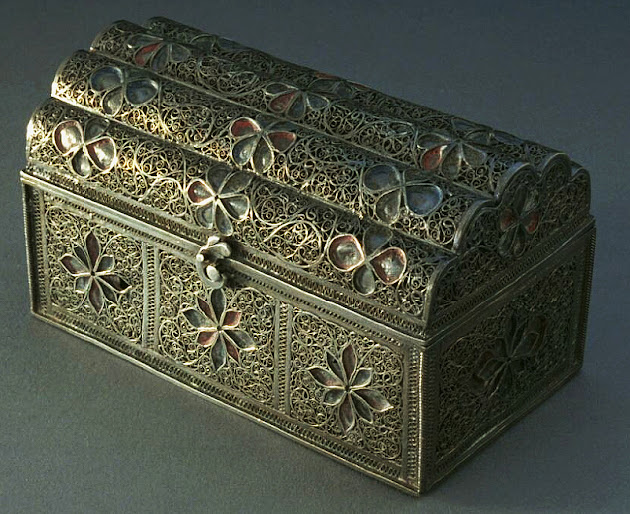




No comments:
Post a Comment